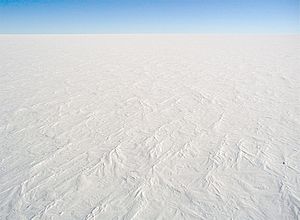Polar desert facts for kids
Polar deserts are very cold, dry places on Earth. They are found in areas with an ice cap climate, which means they are always frozen or very close to freezing. Even though they don't get much rain or snow, like other deserts, polar deserts are different because they are extremely cold all year round. Most of these deserts are covered in thick layers of ice, like ice sheets, and are sometimes called white deserts.
Polar deserts are one of two main types of cold regions, called biomes, found near the Earth's poles. The other type is the Arctic tundra. These biomes cover large parts of Antarctica in the south. In the northern hemisphere, they stretch from the Arctic into North America, Europe, and Asia. Unlike the tundra, which can have plants and animals in the summer, polar deserts are mostly empty. They have flat, permanent ice layers. Even the few areas without ice don't have much life because there is very little liquid water. However, scientists have found tiny living things, like microbes, in the thick ice. These microbes are similar to cyanobacteria and can use carbon dioxide from melting water to survive.
Contents
What Makes Polar Deserts Unique?
The temperatures in polar deserts often go above and below the freezing point of water. This constant freezing and thawing creates interesting patterns on the ground. These patterns can be as wide as 5 meters (about 16 feet) across.
Most of the inside of Antarctica is a polar desert, even with its very thick ice cover. There are also places like the McMurdo Dry Valleys in Antarctica. These valleys have been free of ice for thousands of years because of strong, dry winds. They have temporary streams and very salty lakes, like hot deserts, but they are still part of the polar desert environment.
Polar Deserts and Ice Ages
Polar deserts become more common during ice ages. This is because ice ages tend to be very dry periods on Earth.
Why Polar Deserts Matter
Scientists are worried about how global warming might affect these cold, icy regions. Changes in temperature could cause the ice to melt, which would have a big impact on the planet.
See Also
Images for kids



